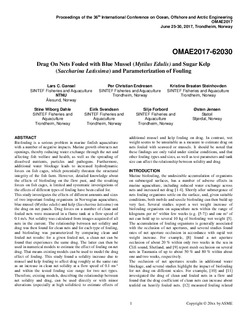| dc.description.abstract | Biofouling is a serious problem in marine finfish aquaculture with a number of negative impacts. Marine growth obstructs net openings, thereby reducing water exchange through the net and affecting fish welfare and health, as well as the spreading of dissolved nutrients, particles and pathogens. Furthermore, additional water blockage leads to increased hydrodynamic forces on fish cages, which potentially threaten the structural integrity of the fish farm. However, detailed knowledge about the effects of biofouling on the flow past, and the resulting forces on fish cages, is limited and systematic investigations of the effects of different types of fouling have been called for. This study investigates the effects of different amounts and sizes of two important fouling organisms in Norwegian aquaculture, blue mussel (Mytilus edulis) and kelp (Saccharina latissima) on the drag on net panels. Drag forces on a number of clean and fouled nets were measured in a flume tank at a flow speed of 0.1 m/s. Net solidity was calculated from images acquired of all nets in the current. The relationship between net solidity and drag was then found for clean nets and for each type of fouling, and biofouling was parameterized by comparing clean and fouled net results: for a given fouled net, a clean net can be found that experiences the same drag. The latter can then be used in numerical models to estimate the effect of fouling on net drag. That means existing models can be used to model the drag effect of fouling. This study found a solidity increase due to mussel and kelp fouling to affect drag roughly at the same rate as an increase in clean net solidity at a flow speed of 0.1 ms−1 and within the tested fouling size range for two net types. Therefore, existing models, describing the relationship between net solidity and drag, can be used directly or with minor alterations (especially at high solidities) to estimate effects of additional mussel and kelp fouling on drag. In contrast, wet weight seems to be unsuitable as a measure to estimate drag on nets fouled with seaweed or mussels. It should be noted that these findings are only valid under similar conditions, and that other fouling types and sizes, as well as test parameters and tank size can affect the relationship between solidity and drag. | nb_NO |
